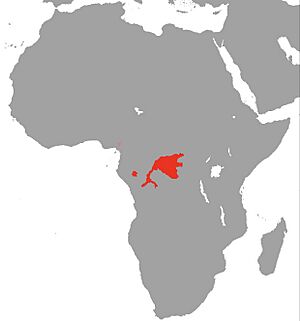West African bichir facts for kids
Quick facts for kids West African bichir |
|
|---|---|
| Conservation status | |
| Scientific classification | |
 |
|
| Synonyms | |
|
The West African bichir (say: BY-cheer), also called the retropinnis bichir, is a cool freshwater fish. Its scientific name is Polypterus retropinnis. You can find this fish swimming in the central Congo River basin and the Ogooué River in Africa. It's a long, thin fish that can grow up to about 34 centimeters (13 inches) long.
Contents
What Does the West African Bichir Look Like?
Bichirs are special fish because they are very old, like living fossils! Their jaws are a bit like those of animals that live on land, not like most other fish. They also have tiny lungs and two small holes called spiracles. These help them breathe air when there isn't enough oxygen in the water.
This bichir has a long, tube-shaped body. It can grow to be about 34 centimeters (13 inches) long. You can tell it apart from other bichirs because its upper and lower jaws are about the same length. Also, if you see a living one, its eyes have creamy-white parts with black speckles.
Fins and Colors
The West African bichir has a unique back fin. It's made of 7 to 9 separate little fins, and each one has a sharp spine on top. Its side fins are thick and have 30 to 32 soft rays. The fin underneath its body has 12 to 15 spines.
The top of its body and its sides are olive brown. They have cool, uneven dark brown marks. Its belly is usually whitish or light beige. The back fin and tail fin are light beige with dark marks in rows. They also have black spots near the bottom of the spines. The side fins have clear black spots at their base and tiny black spots in rows on the webbing between the rays. The fins near its belly and the fin underneath its body are whitish.
Where Does the West African Bichir Live?
The West African bichir is a freshwater fish that lives in warm parts of West Africa. It calls home the river basins of the Ogooué River and the Congo River. It might also live in the Cross River basin in Cameroon. This fish loves to hang out in swamps and areas that flood often.
How Does the West African Bichir Behave?
These fish are quite protective of their space! They are what we call territorial. This means they like to have their own area and will try to scare away other fish that come too close.
When a West African bichir wants to tell an intruder to leave, it raises the spines on its back fin. It also makes quick, thumping sounds. Sometimes, both fish might try to bite each other. Other times, one fish will give up and swim away, making long, moaning sounds as it goes.
Keeping West African Bichirs in Aquariums
Sometimes, people keep the West African bichir as a pet in aquariums. If you have one, remember it will eat almost anything it can fit into its mouth! This includes small to medium-sized animals without backbones (like insects) and animals with backbones (like small fish).


